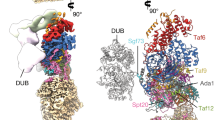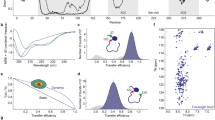Abstract
The SAND domain is a conserved sequence motif found in a number of nuclear proteins, including the Sp100 family and NUDR. These are thought to play important roles in chromatin-dependent transcriptional regulation and are linked to many diseases. We have determined the three-dimensional (3D) structure of the SAND domain from Sp100b. The structure represents a novel α/β fold, in which a conserved KDWK sequence motif is found within an α-helical, positively charged surface patch. For NUDR, the SAND domain is shown to be sufficient to mediate DNA binding. Using mutational analyses and chemical shift perturbation experiments, the DNA binding surface is mapped to the α-helical region encompassing the KDWK motif. The DNA binding activity of wild type and mutant proteins in vitro correlates with transcriptional regulation activity of full length NUDR in vivo. The evolutionarily conserved SAND domain defines a new DNA binding fold that is involved in chromatin-associated transcriptional regulation.
This is a preview of subscription content, access via your institution
Access options
Subscribe to this journal
Receive 12 print issues and online access
$189.00 per year
only $15.75 per issue
Buy this article
- Purchase on Springer Link
- Instant access to full article PDF
Prices may be subject to local taxes which are calculated during checkout





Similar content being viewed by others
References
Gibson, T.J., Ramu, C., Gemünd, C. & Aasland, R. The APECED polyglandular autoimmune syndrome protein, AIRE-1, contains the SAND domain and is probably a transcription factor. Trends Biochem. Sci. 23, 242–244 (1998).
Bloch, D.B. et al. Sp110 localizes to the PML-Sp100 nuclear body and may function as a nuclear hormone receptor transcriptional coactivator. Mol. Cell. Biol. 20, 6138–6146 (2000).
Bloch, D.B., de la Monte, S.M., Guigaouri, P., Filippov, A. & Bloch, K.D. Identification and characterization of a leukocyte-specific component of the nuclear body. J. Biol. Chem. 271, 29198–29204 (1996).
Lehming, N., Le Saux, A., Schuller, J. & Ptashne, M. Chromatin components as part of a putative transcriptional repressing complex. Proc. Natl. Acad. Sci. USA 95, 7322–7326 (1998).
Seeler, J.S., Marchio, A., Sitterlin, D., Transy, C. & Dejean, A. Interaction of SP100 with HP1 proteins: a link between the promyelocytic leukemia-associated nuclear bodies and the chromatin compartment. Proc. Natl. Acad. Sci. USA 95, 7316–7321 (1998).
Michelson, R.J. et al. Nuclear DEAF-1-related (NUDR) protein contains a novel DNA binding domain and represses transcription of the heterogeneous nuclear ribonucleoprotein A2/B1 promoter. J. Biol. Chem. 274, 30510–30519 (1999).
Gross, C.T. & McGinnis, W. DEAF-1, a novel protein that binds an essential region in a Deformed response element. EMBO J. 15, 1961–1970 (1996).
Lutterbach, B., Sun, D., Schuetz, J. & Hiebert, S.W. The MYND motif is required for repression of basal transcription from the multidrug resistance 1 promoter by the t(8;21) fusion protein. Mol. Cell. Biol. 18, 3604–3611 (1998).
Oshima, H., Szapary, D. & Simons, S.S. The factor binding to the glucocorticoid modulatory element of the tyrosine aminotransferase gene is a novel and ubiquitous heteromeric complex. J. Biol. Chem. 270, 21893–21901. (1995).
Christensen, J., Cotmore, S.F. & Tattersall, P. Two new members of the emerging KDWK family of combinatorial transcription modulators bind as a heterodimer to flexibly spaced PuCGPy half-sites. Mol. Cell. Biol. 19, 7741–7750 (1999).
Nagamine, K. et al. Positional cloning of the APECED gene. Nature Genet. 17, 393–398 (1997).
Pitkanen, J. et al. The autoimmune regulator protein has transcriptional transactivating properties and interacts with the common coactivator CREB-binding protein. J. Biol. Chem. 275, 16802–16809 (2000).
Huggenvik, J.I. et al. Characterization of a nuclear deformed epidermal autoregulatory factor-1 (DEAF-1)-related (NUDR) transcriptional regulator protein. Mol. Endocrinol. 12, 1619–1639 (1998).
Szostecki, C., Guldner, H.H., Netter, H.J. & Will, H. Isolation and characterization of cDNA encoding a human nuclear antigen predominantly recognized by autoantibodies from patients with primary biliary cirrhosis. J. Immunol. 145, 4338–4347 (1990).
Hodges, M., Tissot, C., Howe, K., Grimwade, D. & Freemont, P.S. Structure, organization, and dynamics of promyelocytic leukemia protein nuclear bodies. Am. J. Hum. Genet. 63, 297–304 (1998).
Holm, L. & Sander, C. Protein structure comparison by alignment of distance matrices. J. Mol. Biol. 233, 123–138 (1993).
Lee, M.S., Kliewer, S.A., Provencal, J., Wright, P.E. & Evans, R.M. Structure of the retinoid X receptor alpha DNA binding domain: a helix required for homodimeric DNA binding. Science 260, 1117–1121 (1993).
Klemm, J.D. & Pabo, C.O. Oct-1 POU domain–DNA interactions: cooperative binding of isolated subdomains and effects of covalent linkage. Genes Dev. 10, 27–36 (1996).
Haynes, S.R. et al. The bromodomain: a conserved sequence found in human, Drosophila and yeast proteins. Nucleic Acids Res. 20, 2603 (1992).
Aasland, R., Gibson, T.J. & Stewart, A.F. The PHD finger: implications for chromatin-mediated transcriptional regulation. Trends Biochem. Sci. 20, 56–59 (1995).
Wolffe, A.P. & Guschin, D. Review: chromatin structural features and targets that regulate transcription. J. Struct. Biol. 129, 102–122 (2000).
Liu, Z. et al. The three-dimensional structure of the HRDC domain and implications for the Werner and Bloom syndrome proteins. Structure Fold. Des. 7, 1557–1566 (1999).
Delaglio, F. et al. NMRPipe: a multidimensional spectral processing system based on UNIX Pipes. J. Biomol. NMR 6, 277–293 (1995).
Bartels, C., Xia, T.-H., Billeter, M., Güntert, P. & Wüthrich, K. The program XEASY for computer-supported NMR spectral analysis of biological macromolecules. J. Biomol. NMR 5, 1–10 (1995).
Sattler, M., Schleucher, J. & Griesinger, C. Heteronuclear multidimensional NMR experiments for the structure determination of proteins in solution employing pulsed field gradients. Prog. NMR Spectrosc. 34, 93–158 (1999).
Clore, G.M. & Gronenborn, A.M. Determining the structures of large proteins and protein complexes by NMR. Trends Biotechnol. 16, 22–34 (1998).
Neri, D., Szyperski, T., Otting, G., Senn, H. & Wüthrich, K. Stereospecific nuclear magnetic resonance assignments of the methyl groups of valine and leucine in the DNA-binding domain of the 434 repressor by biosynthetically directed fractional 13C labeling. Biochemistry 28, 7510–7516 (1989).
Bottomley, M.J., Macias, M.J., Liu, Z. & Sattler, M. A novel NMR experiment for the sequential assignment of proline residues and proline stretches in 13C/15N labeled proteins. J. Biomol. NMR 13, 381–385 (1999).
Kuboniwa, H., Grzesiek, S., Delaglio, F. & Bax, A. Measurement of HN-Hα J-couplings in calcium-free calmodulin using new 2D and 3D water-flip-back methods. J. Biomol. NMR 4, 871–878 (1994).
Hu, J.-S. & Bax, A. χ1 angle information from a simple two-dimensional NMR experiment that identifies trans 3JNCγ couplings in isotopically enriched proteins. J. Biomol. NMR 9, 323–328 (1997).
Brünger, A.T. et al. Crystallography,NMR system: A new software suite for macromolecular structure determination. Acta Crystallogr. D 54, 905–921 (1998).
Nilges, M. & O'Donoghue, S.I. Ambiguous NOEs and automated NOESY assignment. Prog. NMR Spectrosc. 32, 107–139 (1998).
Sprangers, R. et al. Refinement of the protein backbone angle ψ in NMR structure calculations. J. Biomol. NMR 16, 47–58 (2000).
Cornilescu, G., Delaglio, F. & Bax, A. Protein backbone angle restraints from searching a database for chemical shift and sequence homology. J .Biomol. NMR 13, 289–302 (1999).
Thompson, J.D., Gibson, T.J., Plewniak, F., Jeanmougin, F. & Higgins, D.G. The CLUSTAL_X windows interface: flexible strategies for multiple sequence alignment aided by quality analysis tools. Nucleic Acids Res. 25, 4876–4882 (1997).
Koradi, R., Billeter, M. & Wüthrich, K. MOLMOL: a program for display and analysis of macromolecular structures. J. Mol. Graph. 14, 51–55 (1996).
Nicholls, A., Sharp, K.A. & Honig, B. Protein folding and association: insights from the interfacial and thermodynamic properties of hydrocarbons. Protein Struc. Func. Genet. 11, 281–296 (1991).
Laskowski, R.A., Rullmannn, J.A., MacArthur, M.W., Kaptein, R. & Thornton, J.M. AQUA and PROCHECK-NMR: programs for checking the quality of protein structures solved by NMR. J. Biomol. NMR 8, 477–486 (1996).
Acknowledgements
M.J.B. and Z.L. are grateful for EMBO/EMBL fellowships. This work was supported by the DFG (M.S.), the American Cancer Society (J.I.H.) and the NIH (M.W.C.). We are grateful to G. Stier for providing plasmids for TEV purifications, A. Urbani for advice with fluorescence titrations, H. Oschkinat and P. Schmieder (FMP, Berlin) for recording a NOESY spectrum at 750 MHz, R. Sprangers for help with the structure refinement and M. Saraste for critical reading of the manuscript.
This contribution is dedicated to the memory of Matti Saraste.
Author information
Authors and Affiliations
Corresponding author
Rights and permissions
About this article
Cite this article
Bottomley, M., Collard, M., Huggenvik, J. et al. The SAND domain structure defines a novel DNA-binding fold in transcriptional regulation. Nat Struct Mol Biol 8, 626–633 (2001). https://doi.org/10.1038/89675
Received:
Accepted:
Issue Date:
DOI: https://doi.org/10.1038/89675
This article is cited by
-
Bromodomain and extraterminal (BET) proteins: biological functions, diseases, and targeted therapy
Signal Transduction and Targeted Therapy (2023)
-
Thymic self-antigen expression for immune tolerance and surveillance
Inflammation and Regeneration (2022)
-
Zinc finger myeloid Nervy DEAF-1 type (ZMYND) domain containing proteins exert molecular interactions to implicate in carcinogenesis
Discover Oncology (2022)
-
The cell cycle-regulated DNA adenine methyltransferase CcrM opens a bubble at its DNA recognition site
Nature Communications (2019)
-
Bromodomain biology and drug discovery
Nature Structural & Molecular Biology (2019)



